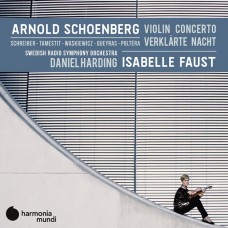|
荀伯格: 小提琴協奏曲 / 昇華之夜
伊莎貝兒.佛絲特 小提琴
安東尼.塔梅斯提 中提琴
尚-古漢.奎拉斯 大提琴
克里斯蒂安.波特拉 大提琴
丹尼爾.哈丁 指揮
瑞典廣播交響樂團
(昇華之夜,1899)和小提琴協奏曲(1936)相隔幾乎四十年 – 前者仍然受到布拉姆斯和華格納慣用風格的影響, 後者源自於在較晚時期當荀伯格設法組合了他的十二音列理論(twelve-note system)中的多種方法. 在後浪漫主義時代的晚期和嚴格的古典時期之間, 佛斯特和她最忠誠的夥伴們帶給我們一個生動活潑的詮釋在二十世紀音樂文學中一些最傑出的幾頁.
The year 1802 was a decisive one for Beethoven: in the autumn, he wrote the ‘Heiligenstadt Testament’, in which he clearly expressed his awareness of the outcome of his inexorably increasing deafness. At almost the same time, he told his friend Krumpholz that, ‘not satisfied’ with his ‘work so far’, he was planning to embark on ‘a new path’. It so happens that the works here, skilfully grouped together by Andreas Staier, correspond precisely to that new direction.
1 Violin Concerto, Op. 36 I. Poco allegro 13:21
2 Violin Concerto, Op. 36 II. Andante graciozo 09:10
3 Violin Concerto, Op. 36 III. Allegro 12:28
4 Verklärte Nacht, Op. 4 Sehr langsam 06:10
5 Verklärte Nacht, Op. 4 Breiter 05:59
6 Verklärte Nacht, Op. 4 Schwer betont 02:17
7 Verklärte Nacht, Op. 4 Sehr breit und langsam 09:30
8 Verklärte Nacht, Op. 4 Sehr ruhig 04:10 |
|



